Online chicken groups are full of queries and complaints about rooster behaviour, that is, the perception of aggression and how to deal with it. No doubt there are roosters that chase, peck and spur folks, but what is most distressing (to me, at least) is the advice that is given overwhelmingly involves being aggressive in return. There are the folks that suggest pinning a rooster down on the ground or hanging him upside down in front of his flock will ’embarrass’ or ‘humiliate’ him into submission. Or the chicken keepers who feel like they rule the roost and anyone who steps out of line deserves to be swatted or kicked in retaliation. And then there is the chorus of ‘roosters are a dime a dozen, turn him into chicken and dumplings’.
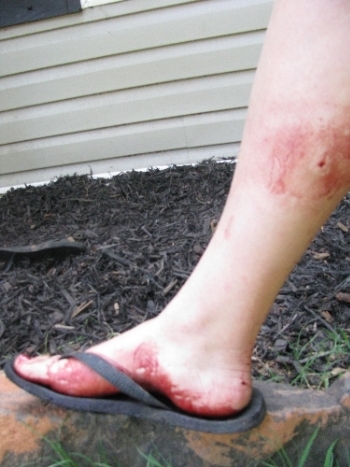
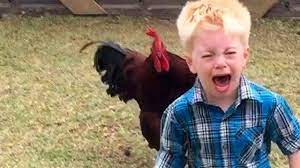
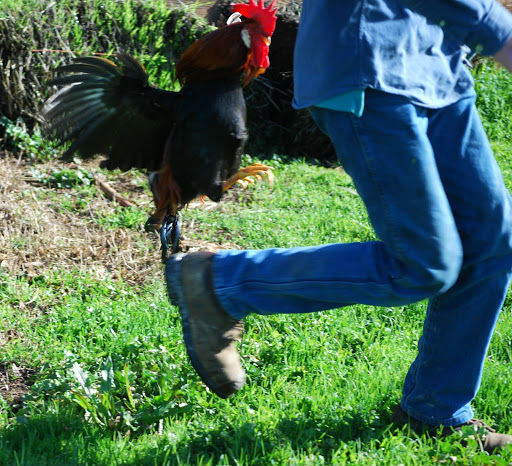

I fear that a lot of misunderstood roosters have been unnecessarily bullied, abused and killed by owners who had no clue that their strategies only made things worse. I can understand people’s frustration, fear and ignorance about chicken behaviour. What I can’t understand is how they think their own aggression will achieve a positive result.
When I first got chickens I erroneously thought roosters were more bother than they were worth and unnecessary for positive flock dynamics. I’ve since learned I was wrong and have had several roosters, all of them good with my girls and me.
I’ve written several posts about the importance of having a rooster and aspects of rooster health. Sometimes I feel I’m pushing back against a deeply held view that roosters are inherently aggressive and superfluous, so it was with real relief when I connected with Sara and Jacob of Roovolution to know that some folks share my philosophy.
They formed a rooster flock after several of their first chicks turned out to be cockerels and have spent hours with their boys, observing and interacting with them. It is out of this commitment to understand their roosters that they have developed some meaningful insight into working with their instinctual behaviour to create a harmonious flock.
The following is their observations and advice to folks wanting to keep a rooster as part of a harmonious flock.
When it comes to misunderstood animals, roosters may well be at the top of the list. All sorts of myths and bad advice have become widespread, leaving many keepers feeling as though they have no choice but to respond to them harshly, expel them from their flock, or avoid keeping them altogether. There is a strong perception within the community that they are ill-tempered, challenging, and simply not worth the hassle. Sadly, there is also a pervasive belief that the only way to engage with them is to be combative or aggressive oneself, in hopes of intimidating them into ‘good’ behavior. In truth, this is the worst approach, and is very likely to take what started as a misunderstanding and convert it into a serious and recurring issue. When this happens, it is always the bird that winds up being blamed and punished. These situations are then used as support that ‘roosters are mean’ and ‘you just can’t fix bad behavior’. Nothing could be further from the truth.
The Truth About Roosters
Well to start, according to recent studies they are likely as intelligent as a four year old human. They are also highly social animals, capable of empathy, forming strong and lasting relationships, and demonstrate immense selflessness by nature. Their willingness to disregard their own wants and safety in favour of caring for their flock is astounding. When humans demonstrate the same sort of love and commitment as a rooster, we call them martyrs and heroes. Roosters are highly protective, a trait driven by this same love and commitment we usually find so admirable. It is this expression of their dedication that typically causes keepers to run into issues, and is often misunderstood as aggression.
I always recommend doing away with the word ‘aggressive’ which implies malice and is simply an inappropriate way to frame what is going on. What is commonly described as aggression in roosters is almost always fear, confusion, survival instinct, or defensiveness. This behaviour is a sign that something is wrong and help is needed, not a cause for anger or offense. Understanding what makes them tick is likely the most important factor in successfully keeping a rooster in the flock.
Hormones
Certain behaviours are easily misunderstood. Changes in hormones can make them seem unpredictable if the keeper doesn’t know what is going on. A rooster’s hormones fluctuate not only throughout the year, but even throughout each day. Testosterone is at its highest in morning and evening and, for that reason, most reactive behavior occurs during these times as well. Spring is another period of very high testosterone because it’s breeding season.
The most problematic period of hormone overdrive is likely puberty which occurs for young cockerels from 3-4 months up to about a year of age. This period also coincides with when most first report that their ‘sweet’ boy has become ‘mean’. This, however, is an erroneous interpretation of what is happening. When hormones enter the picture, that baby bird who was only concerned with exploring and playing suddenly realizes he has a very important job to do. He is destined to be a protector, but he doesn’t know yet what he is supposed to protect against. What follows is often a series of bad guesses, some understandable, some downright laughable. I once watched one of our young boys let out a predator screech at a butterfly as it flew past. It’s not uncommon for that same confusion to come out in ways that are inconvenient, and sometimes downright painful, for the keeper.


Safety Equipment
It is crucial to respond with patience and understanding during these periods. Being prepared will make it much easier to respond calmly. Have basic protective equipment available that can be utilized if you feel it is necessary: long sleeves, gloves, jeans, closed toe shoes (preferably boots), and even shin guards can bolster your confidence and prevent unnecessary injuries if misunderstandings occur. It’s best to avoid flashy prints or colours when dealing with roosters; sticking with muted tones will minimize reactivity. Make a special effort to stay away from red, pink and orange, as this colour spectrum is known to be a trigger. Even so, each bird is an individual and has their own preferences. By paying careful attention you will soon learn which colours and items to avoid with each of your birds.
During puberty roosters are collecting a database of threats and non-threats, attempting to learn how to do their job. For instance, this might come out in an attack on your shoes. In that moment they are making, what seems to them, the safest guess about that possible danger. They will categorize as threat or non-threat based on your response and the overall outcome of the situation. Some folks advocate kicking back when this sort of thing happens, but that will only affirm to the bird that they were right to attack in the first place. All four boys in our bachelor flock are remarkably tame and human friendly, and I credit this to the fact that we have never attempted to dominate, intimidate, or punish them for natural behaviour. When their actions require discouragement, we take the time to gently redirect and allow them to see that they are safe.
We also pay careful attention to triggers and avoid them once we identify them. As a result, they have never been given any reason to view us as a danger or an enemy. Put simply, we adapt to them, rather than expecting them to adapt to us.
Be Aware
Even with the calmest rooster there can still be misunderstandings. It is important to be highly alert and aware of roosters’ movements and position at all times, especially when they are in close range. They are very capable animals with incredible reflexes and speed. Something as simple as a shifting reflection in an eye could prompt a curious peck and result in serious injury. Our roosters love to spend their time in our lap getting snuggles, but we always pay careful attention to their mood and keep more distance when it is clear they are overstimulated and showing weak control over impulses. In addition, we always ensure that our faces are either at a safe distance, or we are in a position where we can gently control their head as needed. Chickens have more vertebrae in their necks than a giraffe, and are capable of sudden and astonishing reach when they set their sights on something of interest.
Nipping
One of the difficult behaviors a keeper is likely to encounter with their rooster is biting or nipping. Many keepers interpret this as an attack, as it can absolutely be painful. However, this is a situation in which they really just don’t know their own strength. There are a few different reasons roosters might nip, but none of them are an attempt to attack. One is to direct, such as when they are annoyed or want attention. Another is to scold or communicate that something has upset them, such as uncomfortable pin feathers being touched. They will also do this in preparation to mate. If you watch a rooster preparing to mount a hen, he will first grab her neck feathers to secure her.
Particularly during puberty, this instinct can come out in unexpected ways. A hand moving near the ground might trigger mating drives and cause them to grab skin with their beak in an attempt to climb onto an arm and mate with it. Roosters have a strong bite, and will sometimes clamp and hold skin with their beak. This can be startling and uncomfortable, but suddenly pulling back will cause unnecessary damage to skin. We find that the best response to this is to either calmly push towards their chest to prompt them to release, or use a free hand to gently remove their beak. Nipping always seems to be either attempts at mating or communication, and should not be viewed as them looking for a fight.
What Does An Attack Look Like?
When attacking in response to a perceived danger, a rooster will charge up to the threat with his neck flared, and quickly jump and kick. He may flog as well, which involves very strong flapping to batter his target. The important thing to note with this is that there is typically no significant delay. They approach quickly and immediately engage with a high level of urgency which is your clue that they perceive a serious threat that must be dispatched. Because this is a fear response, fighting back will only cause the attack to intensify. The best thing to do is gently create a barrier in order to ensure no harm is done to either party. One of our boys often panics over the way my pants or shoes move, so I often choose to just raise my leg and allow him to kick the sole of my shoe until he sees that the ‘aggressor’ is not coming after him.
You can see the initial attack against the pants after they move more than he was expecting when he pecks at them. I extend my leg to keep him at a short distance, then stand to ensure my face is out of range. Once he has had a moment to settle, I pull the pants tight against my legs before letting him inspect them in order to ensure no more unexpected movement will occur. When he realizes that there is no danger after all he quickly disengages and resumes normal activity. Any object that can be held between the bird and his target will work as well. I have even thwarted these situations simply by holding the bag of soiled coop litter or folding stool between us as I leave the run. If the perceived danger is an object, say a container or tool, it can be set down to allow them to attack until they see that it is not responding in a frightening way. Sometimes they just need the opportunity to feel that they did their job and see for themselves that the situation is not threatening.
Challenging
Challenging can look similar to attacking, with one important distinction: it typically takes the form of neck flaring, but with the body lowered and feet planted. This is intended to intimidate the opponent into backing down, and will progress into jumping and kicking only if neither concedes. There is a delay here while they test whether simply showing off will get their message across. This type of behaviour is what you would expect to see during pecking order change ups or flock disputes. It might be directed at another rooster in the flock, or even the keeper themselves. If done to the keeper, it’s a sign they perceive a challenge or feel the keeper stepped out of line in some way, often by taking on a role the rooster feels should be his. This could be something as simple as calling the girls for treats or getting too close with his favorite hen.
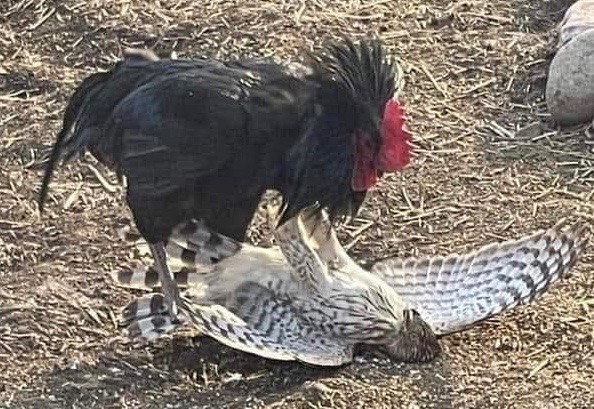

In this situation the goal should be to reassure him that he is the leader and that no challenge is intended. You can give him treats to give the hens which shows that you support him in his job and that you are not interested in engaging in those competitions with him. This is why it is never recommended to run or fight back. The best thing is to slowly and calmly move into his space to force him to turn and leave. He doesn’t wind up ‘winning’, but isn’t defeated either, and learns that you aren’t challenging him.
When it occurs within the flock it’s best to let them sort out the dispute, as long as nobody is in danger of serious injury, and it should resolve fairly quickly. The weaker bird usually concedes and the winner should allow the interaction to end. If the dominant bird pursues the loser and continues attacking, or if neither is willing to back down, it will become appropriate to intervene. Ultimately, the pecking order has to be sorted out for the flock to settle into a peaceful social structure. The keeper should intervene only as much as is necessary to ensure all members of the flock are safe while establishing their hierarchy.
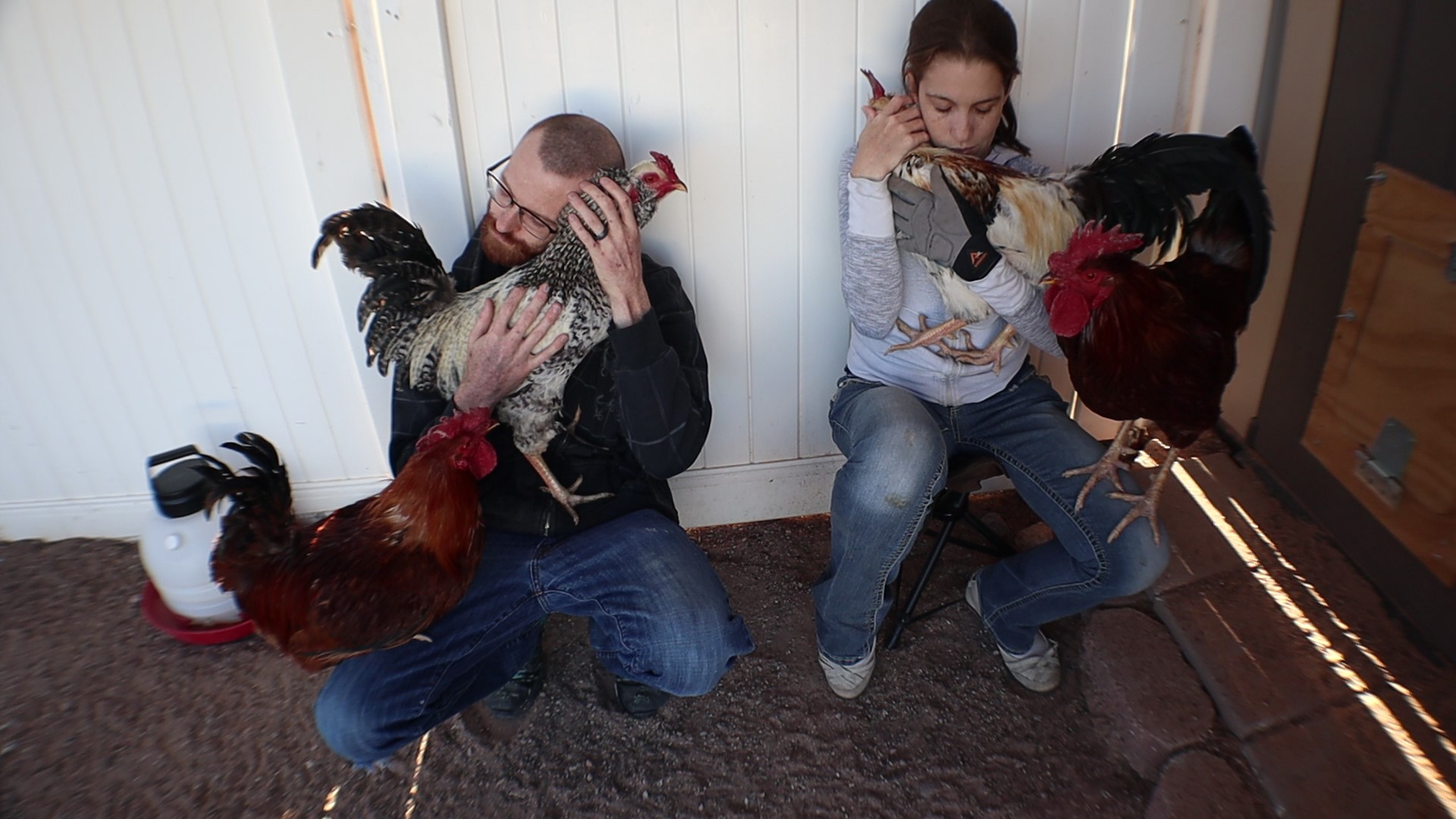
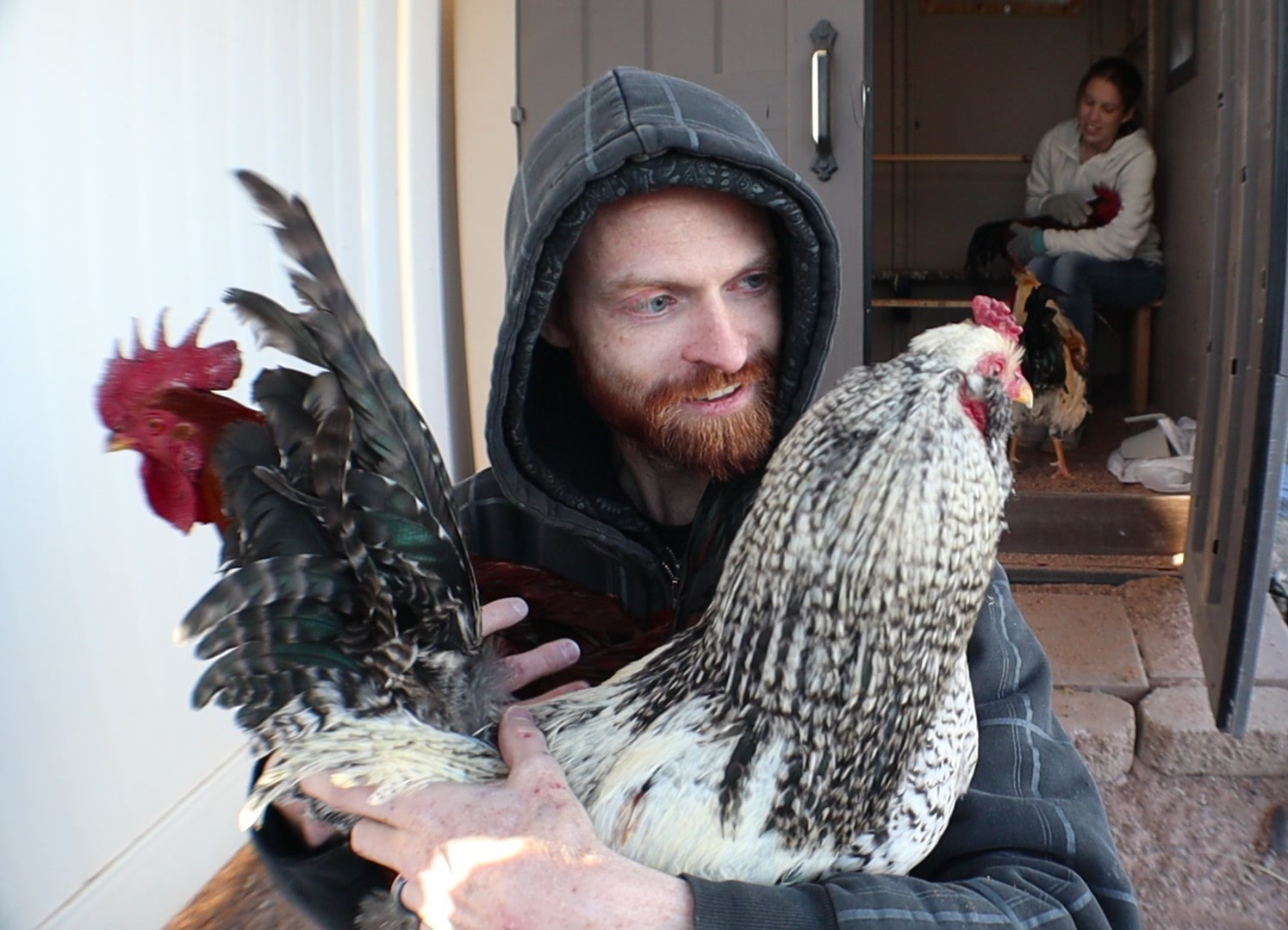
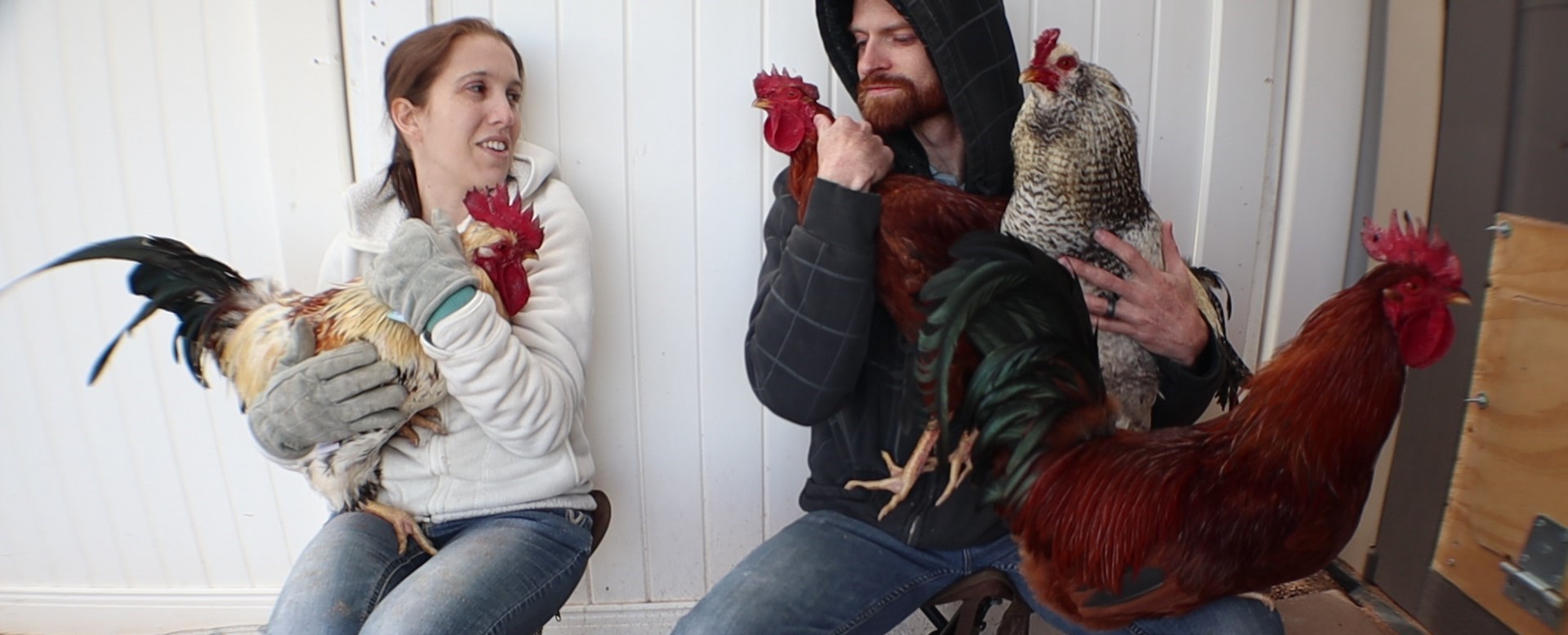
The Harmonious Flock
It’s my sincere belief that, like humans, all roosters want a peaceful and harmonious relationship with their flock and their keepers. When it comes to having a relationship with a rooster, it’s not only about doing the right things, but actively avoiding doing the wrong things as well. It is so easy to burn bridges when we make the mistake of taking things personally and letting emotion get the better of us. Having gained an understanding of what is really driving these more challenging behaviors, as well as a compassionate, psychologically grounded strategy for response, you are well equipped to develop and maintain a loving and deeply rewarding relationship with any roosters who call your coop home.
If you have questions or are interested in more specific advice on working with a rooster in your care, please feel free to reach out to us by email at jointheroovolution@gmail.com

Sara and Jacob Franklin came together over their shared love of all animals. As caregivers for their two flocks, they have worked diligently to develop a more intuitive and compassionate approach to husbandry, which is rooted in animal psychology rather than tradition. They now spend their time sharing advice and insight with fellow keepers in order to help them develop and maintain a closer bond with their birds.
Many thanks to Sara and Jacob Franklin of Roovolution and Rooster Allies for sharing their story, video and photos, used with permission.

I worried about all of my roosters and found that day they can happily live as bachelors in a tribe as long as there aren’t any hens around to fight over. I had an entire coop filled with roosters and it was harmonious and lovely. I have no problem with two as long as one is willing to be subordinate. Thank you for such a wonderful and though provoking article, it really explained a lot of things that us humans stupidly interpret as being aggressive or unsavory when we need to realize roosters are not critical thinkers. Well done. I’m going to print this and put it in my log book
LikeLiked by 2 people
Thank you so much for the positive feedback. We are definitely firm believers that most of the issues encountered with roosters (and all animals) comes down to communication challenges, rather than malice or aggression. We are so grateful to Claire for providing us a means of getting the information out there in hopes that it can help others develop a closer relationship with their boys. 🙂
LikeLiked by 1 person
Great article. You should post this on Backyard chickens. There is a lot of bad advice there. I wondered why my rooster doesn’t seem to like my raincoat, yet he’s ok if I’m not wearing it. Very interesting!
LikeLiked by 2 people
Thank you so much! I will actually be sharing the article on BYC today. I haven’t tried going out to our flock in a raincoat, but I imagine the response would be similar. Over the winter I had remarked to my mother how cold we have been during visits with the flocks. She was nice enough to pass on a down coat for use during coop chores. When I received I realized it is trench coat length, very poofy, and brick red! Needless to say, it has never been used in the coop. 😉
LikeLiked by 1 person
I love this article and I think it’s going to help me maintain a great relationship with my sweet rooster, Ducky. My other rooster is very standoffish and not interested in people at all. His mating behavior with the hens is very intense and there are feathers all over my yard and constant screeching from the girls. I don’t have enough hens (11) for two roosters. Both are good protectors. I tried offering up the more aggressive one online but no one wants him. What would you do?
LikeLiked by 1 person
You have a few options: get more hens; rehome one of the roosters; or split you flock in half and have two groups each with a rooster and 5 hens. That, of course, would require you to build another coop and run. Is that possible?
LikeLike
Thanks for the wonderful information. This year I inherited 27 chickens and three roosters. They were all free range and there were no problems. Then we realized everybody had mites pretty bad, so we dealt with that successfully but decided to keep them in a pretty large run. They still got long fine although one of the roosters passed away. Then we had a broody hen and she hatched 3 chicks and one was you guessed it, a rooster and he is a big boy like his daddy. Recently he jumped two older hens and they both died. I have no idea why or what actually happened but I had seen him on top of them. He is chill with me and the other two roosters as he grew up with them I suppose. Any info on the mating and hen death would be appreciated if you know something on that topic? In gratitude, Perry
LikeLiked by 1 person
@Perry I hope you see this response, as I am not seeing a way to reply to you directly. I will start by saying it is incredibly rare for a rooster to kill hens on purpose. What will sometimes happen is that a young and over-zealous rooster will mount too roughly and cause neck injury or extreme stress which can lead to heart attack. Depending on how old the hens were it could have been that their hearts couldn’t take the situation, or general fragility could have allowed serious injury to result. When roosters are young, they are often unnecessarily rough in their mating attempts. This is really a problem of inexperience and hormones run amok, and should settle down as he matures and learns to manage all of that. If you are sure that the deaths were a result of his advances and not something else that could have coincided with him taking an interest in them, it could be wise to section off an area of the run for him until he settles down some. If the remaining birds are all younger, in good health, and able to get away if they feel overwhelmed by him, that might not be necessary. However, if you have other older gals it would likely be worth taking some extra precautions. Just as a reminder, early morning for a couple of hours after waking and late evening for the couple of hours before they go to roost are the times when hormones are at their highest. You might try allowing them all together for a short time mid-day under supervision to see how they are interacting and get him some time with the flock. Supervision would be required so that you can intervene quickly if things escalate and anyone could be in danger. If that goes well, you could put him in a “time out” pen during only those most out of control times, just until he has had some time to mature. Do keep in mind that roosters learn “polite” mating largely as a result of practice and feedback from the hens. He will need to somehow get that learning under his belt, so if he is just too rough on the older members of the flock no matter what time of day, you might consider letting him have some time mid-day with just the ones nearer his age who are more equipped to handle his energy level. If you see that he is doing anything so violent that he can’t safely interact with anyone, please toss an email to jointheroovolution@gmail.com and I would be happy to talk with you directly to try to help figure out a solution.
LikeLiked by 1 person
Came here after listening to the Roovolution folks on a podcast today. I have to say I am a bit skeptical after hearing they have two year old roos in a bachelor pen. That seems way easier than having older roos with a flock of hens. In my experience the roos get worse over time. With my last one I weathered 5 springs until I had enough. Every spring he would go berserk, then calm down again. Tried to give him away at 5 years old, but he mellowed out a bit again, so lasted another year. Finally gave him away the next spring because he was just too much of a pain. Trouble with having a roo with the flock is when your hens are aging and need special care you might make some of them squeak sometime. So now he regards you as a threat and acts accordingly. He was great about tidbitting, calling alarm for (real) threats, welcoming new chicks, herding hens to the coop at night. He also saw way more threats than were real and would keep hens confined to the run instead of watching while they ranged because that seemed safer to him. He was a brute about mating and most my hens had bare backs. He would relentlessly hound any hen that was sickly and drive her away. He did cause a lot of upheaval in the flock. I don’t think for a moment that he was evil or meant to do wrong or any of such nonsense. I felt really sad to give him up. But the hens are so much happier without a roo to bug them! My flock became so much more peaceful. Without a roo sounding the alarm every time I approached and chasing hens away from me my hens are so much tamer now. I can pick any of them up now, while I had the roos, they would run away screaming. That was the deciding factor for me – I didn’t like the distance the roo created between me and my hens. But here I am, got a few roos from a straight run order this spring, keeping my favorite one because I like the crowing, and he’s cute, and hope springs eternal. We’ll see…
LikeLiked by 1 person
I think Sara and Jacob’s (the Roovolution folks) success is due to the amount of time they’ve spent with their boys to really understand and manage flock dynamics. I have had several roosters that have been nothing but good to me and the hens, so it’s hard for me to relate to those that have challenging roosters. I have also had very few issues dealing with pecking or bullying within the flock so I think that speaks to something I am doing right. Good luck with your new boy.
LikeLike
Thank you! Yeah, my main point was really it’s a whole different thing having a rooster pet flock in a separate bachelor pen, that are only youngsters still, from having them in with the hens and much older. I sang my rooster’s praises when he was two years old, but things change. I want to hear from people who have a 6 year old rooster or older with their flock of hens of all ages and the roo is still being a sweetheart. I have not heard that, ever, I think.
LikeLiked by 1 person
Yes, my oldest rooster was five and was a sweetheart up until he died. My current rooster is three. I think I have avoided some issues by only having one rooster at a time in a flock of 25-30 hens. Chickens can live to 10-12, but most die long before then due to predators or pathogens so it would be interesting to see how age affects behaviour.
LikeLike
Oh, that gives me hope. I have three Marraduna Basque cockerels, one is huge, started crowing and harassing the pullets at 8 weeks. The one I’m keeping is smaller and friendly, easy to pick up, adorable. We’ll see. My oldest hens are seven years old – I have three left out of 14 in my original flock…
LikeLiked by 1 person
This definitely gives me food for thought as I am undecided about having a rooster. I will read more of the posts on roosters & give it serious consideration.
LikeLiked by 1 person
I need help, my chickens really get me upset. They’re greedy and very disrespectful. I just can’t seem to not get angry and upset. I hate starting my mornings off like this. I don’t have a problem with my two roosters and hen. I’m trying to protect the small chickens. This is my first time having hens and roosters all together. I sometimes separate them. I even quarantine some of them at times. Nothing works. I almost always loose my temper.
LikeLiked by 1 person
Chickens are flock animals and have a pecking order. They don’t like change and disruptions in their flock dynamics. Separating them for short periods of time will just create more issues when they come back to the flock. It sound like you’ve got issues between birds of different sizes/ages? That sometimes requires a gradual supervised integration. I’d be curious to know what is your ratio of roosters: hens? That might be causing some of those issues. It also might be due to their age (i.e. teenage hormones). What you are describing is normal chicken behaviour that can be managed. Maybe you need fewer birds or a different set up? Maybe chickens aren’t for you?
LikeLike